Menus
- Bikes for A2 driver’s license holders
- Comparison test with another evaluation model
- Honda CMX 500 Rebel
- Kawasaki Z 400
- KTM 390 Duke
- Royal Enfield Continental GT 650
- Triumph Street Triple S (A2 version)
- Yamaha YZF-R3
- survey
- MOTORCYCLE test result
- Conclusion
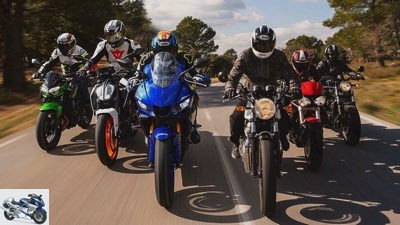
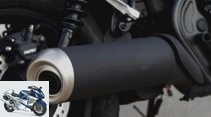

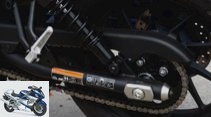
46 photos

Jorg Kunstle
1/46
Six motorcycles compete against each other in the 48 hp comparison test. The models Kawasaki Z 400, KTM 390 Duke, Yamaha YZF-R3, Royal Enfield Continental GT 650, Triumph Street Triple S and Honda CMX 500 Rebel are included.
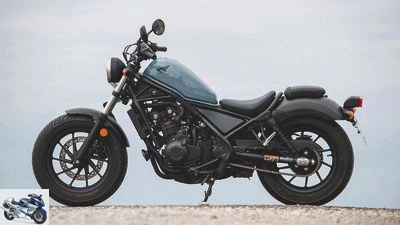
Jorg Kunstle
2/46
If you have an A2 driving license, you can drive motorcycles with a maximum of 48 HP, with a power to weight ratio of 0.27 HP per kilogram.
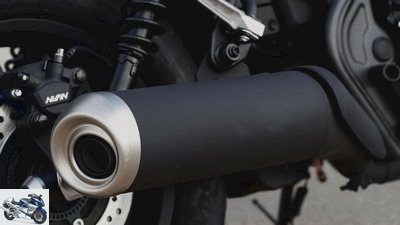
Jorg Kunstle
3/46
When it comes to the design of the exhaust system, the Honda is very frugal.
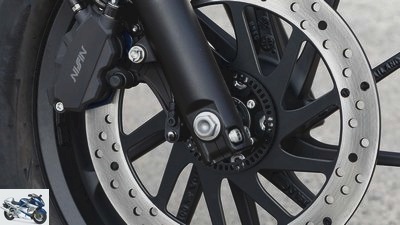
Jorg Kunstle
4/46
Double-piston floating caliper and a disc, here before braking.
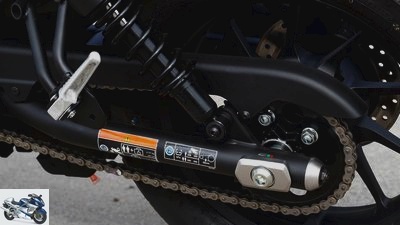
Jorg Kunstle
5/46
The swing arm and axle mount are almost ingeniously simple.
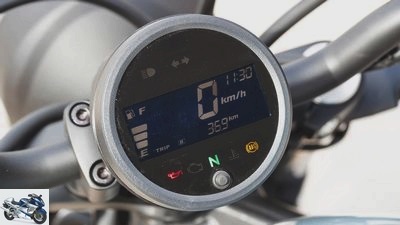
Jorg Kunstle
6/46
The square in the round: an LCD panel provides the most necessary information.

Jorg Kunstle
7/46
The rear suspension travel is quickly used up on bumpy roads.
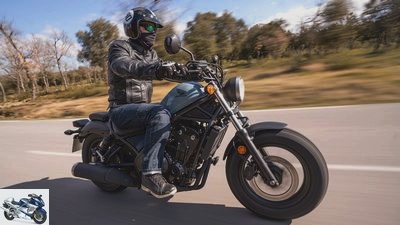
Jorg Kunstle
8/46
In this comparison, the Honda represents the cruiser – as their most successful representative.

Jorg Kunstle
9/46
There are big differences between the six motorcycles.
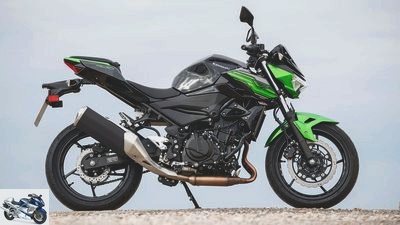
Jorg Kunstle
10/46
The Kawasaki Z 400 only shows corners and edges on the outside.
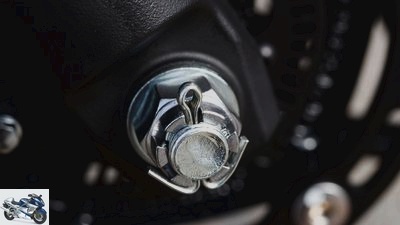
Jorg Kunstle
11/46
On the Z 400 also on the front wheel: the good old Kawasaki split pin as a safety device.
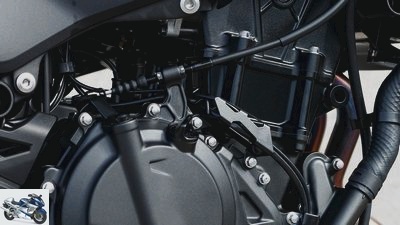
Jorg Kunstle
12/46
Given the price, the stainless steel exhaust system cannot be taken for granted.
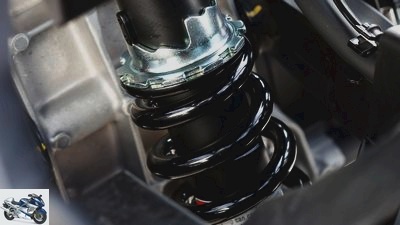
Jorg Kunstle
13/46
The central spring strut can only be adjusted in terms of the spring preload.
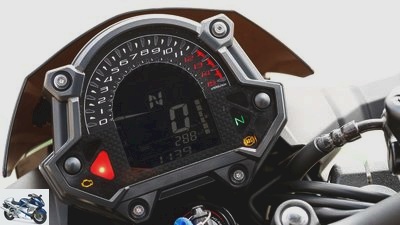
Jorg Kunstle
14/46
The surround of the instrument exudes a touch of steampunk charm.
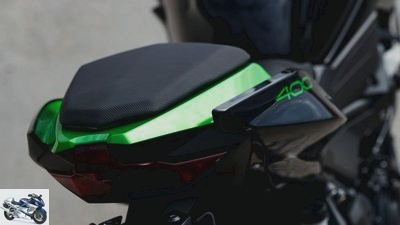
Jorg Kunstle
15/46
Not the most comfortable pillion seat in the field, but at least a decent one.
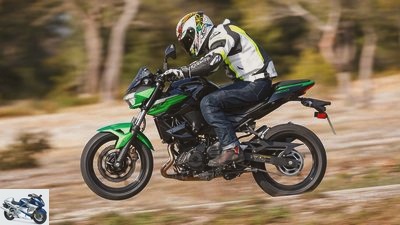
Jorg Kunstle
16/46
Every now and then we prefer to raise the front wheel instead of a warning finger.
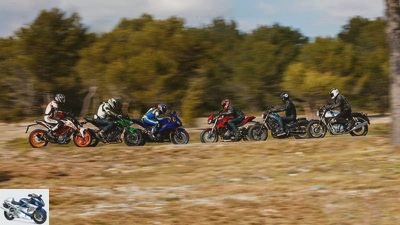
Jorg Kunstle
17/46
Athletes, naked bikes, cruisers or classics – everything is offered.
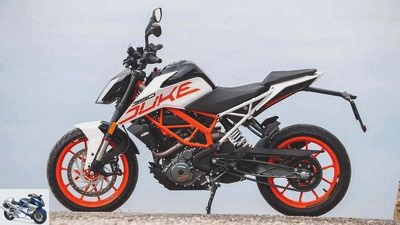
Jorg Kunstle
18/46
After just a few bends you get into a real flow.
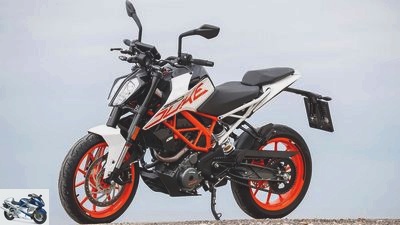
Jorg Kunstle
19/46
The headlight is an important element of the KTM design language.
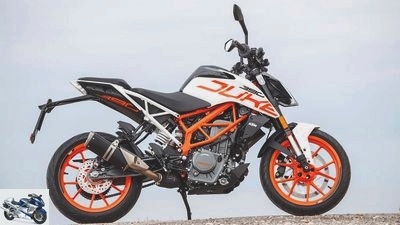
Jorg Kunstle
20/46
Light, sporty, fast, inexpensive – and an eye-catcher on top of that.
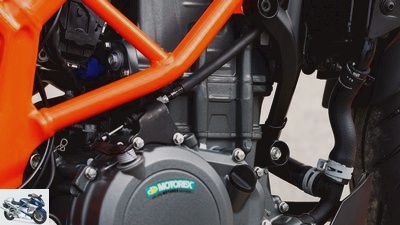
Jorg Kunstle
21/46
The single cylinder was fitted very tightly into the tubular space frame.
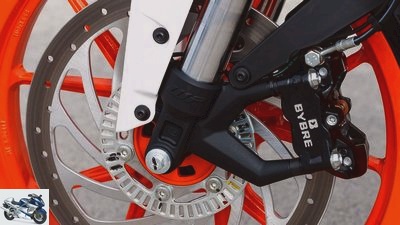
Jorg Kunstle
22/46
A large disc and the Bybre four-piston caliper slow down energetically.
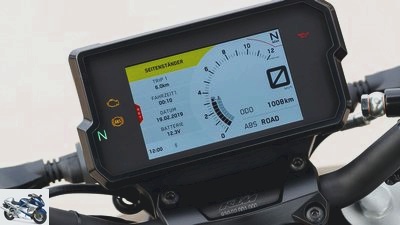
Jorg Kunstle
23/46
The TFT display impresses with its presentation, you almost think you’re on the laptop.

Jorg Kunstle
24/46
Razor-sharp past the wide-angle lens – no problem at all with the nimble 390 Duke.

Jorg Kunstle
25/46
The south of France donated the testers a generous advance of the sun for the 2019 motorcycle season.
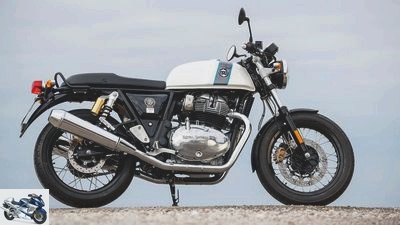
Jorg Kunstle
26/46
The Continental GT embodies robust sportiness.
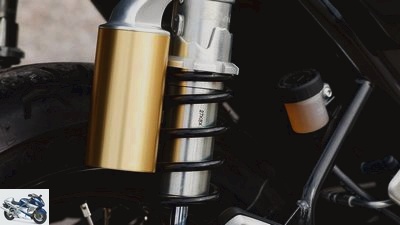
Jorg Kunstle
27/46
Neatly executed struts, unfortunately a little underdamped in the rebound stage.
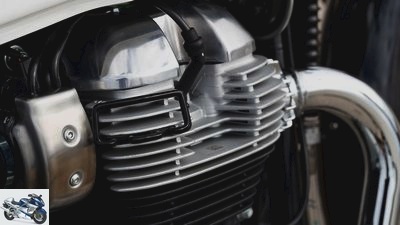
Jorg Kunstle
28/46
A rail on the cylinder head prevents burns on the station wagon and the driver’s knees.
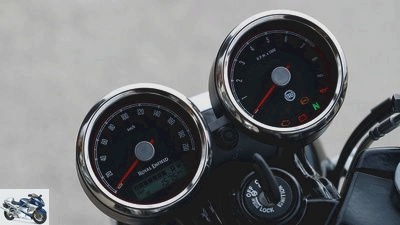
Jorg Kunstle
29/46
The round instruments combine classic optics and modern electronics.
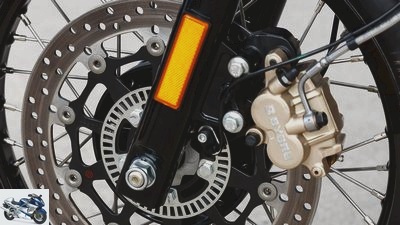
Jorg Kunstle
30/46
The single disc brake decelerates well, but feels spongy.
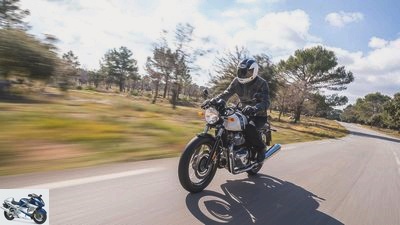
Jorg Kunstle
31/46
A cafe racer with narrow, not too deep handlebars and set back footrests.
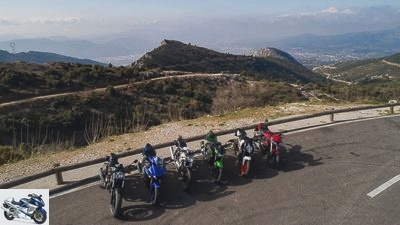
Jorg Kunstle
32/46
We are curious to see who can win the comparison test?
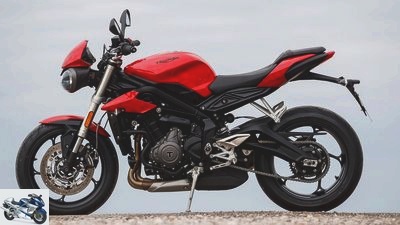
Jorg Kunstle
33/46
The Street Triple is top class – in price, but also in its properties.
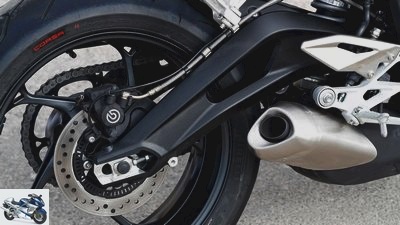
Jorg Kunstle
34/46
The swing arm, axle mount and ratchet system are of high quality.
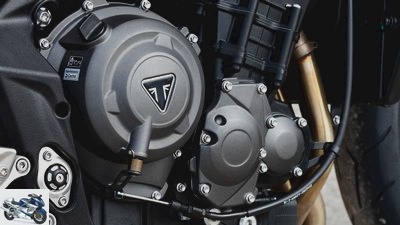
Jorg Kunstle
35/46
Actually overqualified for 48 hp: the 660 three-cylinder from Triumph.
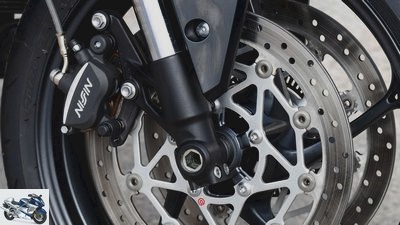
Jorg Kunstle
36/46
Energetic and easy to dose: double disc with double piston floating calipers.
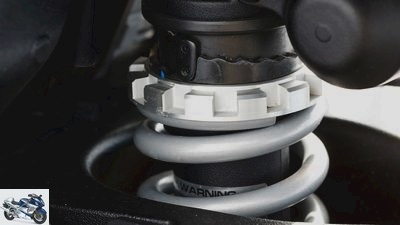
Jorg Kunstle
37/46
The spring preload of the strut can be finely adjusted.
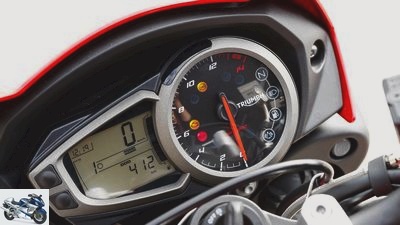
Jorg Kunstle
38/46
Fuel gauge, speedometer, various odometers, speed, time – more information is a luxury.
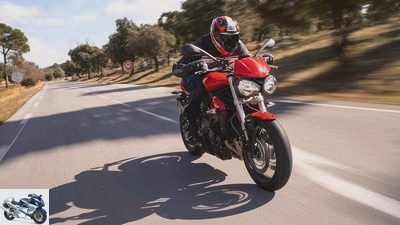
Jorg Kunstle
39/46
Even in the 48-hp version, the tried and tested Street Triple remains a great success from Triumph.
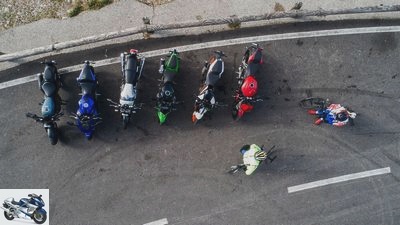
Jorg Kunstle
40/46
Their displacement ranges from 321 to 648 cm³ and they are used in a wide variety of motorcycles.

Jorg Kunstle
41/46
Yamaha YZF-R3 – the little one with the racing genes.
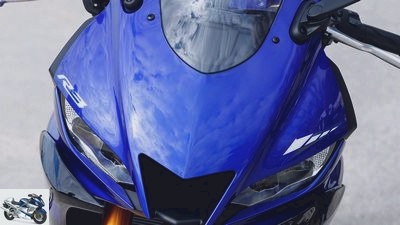
Jorg Kunstle
42/46
The R3 is similar to the R1 and deserves to be respected by its drivers too.

Jorg Kunstle
43/46
The single-disc brake also meets sporting demands.
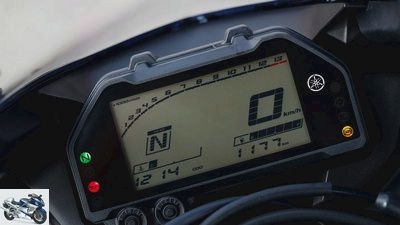
Jorg Kunstle
44/46
Typical Yamaha display. The speed can jump up to the red area.
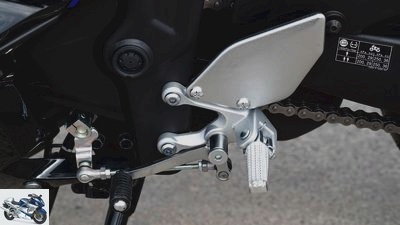
Jorg Kunstle
45/46
The shift linkage consists of simple steel parts, but is continuously adjustable.
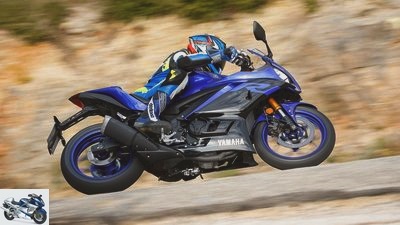
Jorg Kunstle
46/46
On the R3, the driver finds such an ambitious and sporty sitting posture almost by himself.
48 hp motorcycles (2019) in a comparison test
Bikes for A2 driver’s license holders
New items 2019
In the comparison test of the 48 hp motorcycles of the 2019 model year, the Kawasaki Z 400, KTM 390 Duke, Yamaha YZF-R3, Royal Enfield Continental GT 650, Triumph Street Triple S and Honda Rebel compete against each other.
The best drive for a motorcycle that fits into the A2 driving license class, the best compromise between power development and costs seems to be a two-cylinder in-line engine. Four out of six motorcycles in this comparison are equipped with such engines. Their displacement ranges from 321 to 648 cm³ and they are used in a wide variety of motorcycles. While the Honda Rebel was designed as a cruiser or rather a soft bobber, Yamaha is looking for the other extreme with the sporty YZF-R3. The new Kawasaki Z 400 represents a modern naked bike and the Royal Enfield a classic type of undisguised sports motorcycle, a cafe racer. Its engine, with its 90-degree crankshaft and air cooling, is constructed very differently from the other, consistently water-cooled, in-line twins. KTM competes in this class with an extremely light and lively motorcycle; Due to its low weight, the single cylinder may be the 390 Duke did not fully utilize the 48 hp that were actually allowed, but still impressed with brilliant driving performance. And the A2 version of the Triumph Street Triple offers an example of how a motorcycle rides that was actually designed for a lot more power, but was throttled to 48 hp.
Comparison test with another evaluation model
KTM and Triumph also fall under the umbrella term naked bike, but when you ride you quickly notice that this classification more obscures their character than describes it. Because the KTM drives almost like a supermoto, the Triumph, on the other hand, clearly shows its road racing genes – it was created parallel to the daytona 675 super athlete, which is no longer produced, and has many parts in common with it.
Jorg Kunstle
With this range, a comparison test that directly compares the six candidates according to every criterion of the 1,000-point evaluation is not possible. The MOTORRAD testers did not want to accuse any motorcycle of what, according to its design, it cannot do at all. Nevertheless, the six motorcycles of Mission A2 were rated. And yes, there is a motorcycle with the highest score, one with the lowest score, and everything in between. The testers associate this presentation with the request to read it less like a school report card or the ranking of a MotoGP race, but rather as a character profile, as a decision-making aid in view of the question of which machine best suits your own needs.
Honda CMX 500 Rebel
The 2018 Honda CMX 500 Rebel only narrowly lost the race for the best-selling 48 hp machine in Germany to the KTM 390 Duke. The Rebel was newly registered 1,565 times, the Duke 1,600 times, both to over 90 percent by private individuals, i.e. without special authorization campaigns by the manufacturers. On the contrary: Honda Germany couldn’t deliver as many motorcycles as were ordered. There is no doubt that the Rebel is extremely popular in Germany. Not least with women. Their share among Rebel buyers is 35 percent, according to Honda Germany, but there it is suspected that it is even higher in practice because apparently many men sign the purchase contracts for their wives’ motorcycles. No matter how high the number of unreported cases, of all so-called “natural persons” who registered a motorcycle in 2018, only 14.3 percent were women.
Regardless of gender, the low seat height on the Rebel primarily attracts people for whom a motorcycle with a higher seat is a high psychological hurdle. Understandable, but from the tester’s point of view it must be noted that the psychological advantage comes at the price of tangible disadvantages in terms of driving dynamics, driving comfort and, ultimately, driving safety. The spring travel of the Rebel on the rear axle of 95 millimeters is not the shortest in this comparison, but it is clearly too short in combination with the present adjustment of the suspension struts. Without having to drive too fast, the tire suspension is quickly required on bumpy roads and, soon afterwards, the “intervertebral disc suspension”. Because of the passive sitting position, it is hardly possible to cushion the roughest bumps in the knees. If you hit a pronounced shaft in an inclined position, the machine stirs pronounced around the longitudinal axis. This is not dangerous, but it is an indication that the tire is severely deformed during peak loads and thus brings undesirable steering impulses into the chassis. Finally, the rebel’s low lean angle is limited by their low construction. Even when swinging loosely on winding roads, it often hits the left and right. And no, this doesn’t only happen to cocky testers, who are often suspected of deliberately misunderstanding the purpose of a cruiser or soft bobber.
Jorg Kunstle
At the beginning of the test drives it was almost impossible to bring the front wheel to the lock limit when braking; the brake pads had to be braked vigorously to bite harder. However, the hand force remains quite high, and it is advisable to always use the rear brake. Because of the rear-heavy design of the Rebel, it can provide a large proportion of the deceleration performance. The engine is far more convincing than the chassis. For use in the characteristic tubular steel frame of the Rebel, its peak power has been reduced by two horsepower compared to the CB 500 F and CBR 500 R, and it has been strengthened in the medium speed range. However, this has not fundamentally changed its characteristics; he has remained a lively guy, but pulls through cleanly and without chopping even from lower speeds under load. It does that even better than the comparison of torque and acceleration values suggests. As the performance diagram shows, the rather placid driving performance is not due to the engine itself, but is solely due to the long overall ratio.
Kawasaki Z 400
It is the much-cited “sum of all properties” that brings the Kawasaki Z 400 far ahead in this comparison. The new naked bike, based on the Ninja 400, only shows pronounced corners and edges on the outside: on its small cockpit fairing, the front fender or the pointed rear. In terms of engine characteristics, steering properties and ease of use, however, it is very pleasing, and one should not equate this statement with boring. The two-cylinder in-line engine has 399 cc, 78 cc more than the similarly designed Yamaha engine and 26 cc more than the KTM single-cylinder. The Kawasaki translates these advantages – significantly larger displacement in one case and its division into two cylinders in the other – into an exemplary linear power delivery. That means noticeably more torque in the lower and middle range, more peak performance and a high revving speed that continues up to 11,500 rpm. In conjunction with an overall gear ratio that is not chosen for too long, this gives you fast acceleration values and good pulling power.
Jorg Kunstle
Although the measured values are not better in every speed range than those of the light KTM or the candidates with more displacement, they point to an important fact: Whenever it comes to accelerating from relatively low speeds, the Z 400 is easier to use driving requires less manual work than the KTM, the Honda, the Royal Enfield or the Yamaha. Not a bad approach for a motorcycle designed primarily for entry-level users. And if you develop sporting ambitions with increasing driving experience, you don’t need another motorcycle right away. You can also drive briskly towards the curve on the Z 400, step down two gears and accelerate quickly from the apex from 8,000 rpm. The only drawbacks that are noticeable during such exercises are a blaring tone of the motor and tingling vibrations. The Kawasaki masters the proportion of sporty driving determined by the chassis anyway. It can be turned easily and precisely, cushions and dampens in the range between crumple-soft and too tight and offers enough ground clearance for ambitious leanings. The crisp bite of the front brake fits well, the ABS, on the other hand, works more defensively. The sitting position on the Z 400 is kept very low; The seat cushion is sharply lowered directly behind the tank.
This may suit smaller drivers, but it always allows young and old to slide forward towards the tank. Except when accelerating vigorously. Is that why the colleague in the picture next door loves lifting the front wheel? Whatever the case, a padding 20 millimeters higher in the front, narrow area of the bench would hardly affect the safe standing in front of red lights, but would make the much more important driving even easier. Up until the Z 400, none of the testers thought it possible that there would be a clutch that was even too easy to operate. Now they know better. In fact, drivers who have got used to the so-called “careful finger” on the clutch lever should be careful not to let the clutch slip unexpectedly while driving at full speed. All that is needed is an unconscious pull on the lever. At the end of this text and the adjacent data box, the Z 400 deserves great praise for its low price. 5,595 euros plus additional costs make it a tempting offer.
KTM 390 Duke
The older man, who worked his way up the Col de l’Espigoulier with his Honda Varadero 125 collecting herbs from one stop to the next, pointedly named an important reason for the success of the KTM 390 Duke: “I like that one best,” he said and pointed to the orange-white-black eye-catcher. He wasn’t the only one at this southern French motorcyclist hotspot who gazed at the KTM. Conspicuous, but not penetrating, modern, but not aloof, the Duke hits the nerve of European motorcyclists even when standing. And – much more importantly – it doesn’t stop there. If you sit down, let the single-cylinder rumble and then immediately enter a pass road of the quality of Espigoulier, you will find yourself in a veritable flow after just a few curves.
Even in the upper, particularly tightly looped passages, this flow does not break off and continues the entire descent on the north side. When asked what it was like, there is a high probability that someone who is so happy will utter a little differentiated hymn of praise, repeatedly using the term “cool”. So much for the sensual qualities of KTM. It takes a long time until one or the other point of criticism has fought its way into the tester’s consciousness, but these are always accompanied by an immediately relativizing but. Something like this: The engine has a noticeable hang at 6,000 rpm, as can also be seen in the performance diagram. But that’s where he gets to the point. It is not without reason that it received the best rating for acceleration together with the Triumph.
Jorg Kunstle
And further: The direct response, almost jumping to the throttle commands, can be quite annoying when trying to swim without jerking in city traffic. But that’s not what this lighter was designed for. Third: the shock absorber has a long idle travel and does not respond well. But that only really becomes noticeable on bumpy roads. And last but not least: the Metzeler Sportec M5 tends to slide when accelerating in an inclined position than the Dunlops of the Kawasaki and Yamaha. But you don’t have to open the gas in deep lean angles as if you wanted to become world champion. We see that the 390 Duke enjoys a huge bonus. Regardless of that, she can brake really well. It rightly received the best ratings for effectiveness and controllability among single-disc brakes.
It is only surpassed in this test field by the Triumph and its double disc. And despite her motor skills, she uses very little fuel, least of all six motorcycles. Despite the relatively small eleven-liter tank, it manages an impressive 324 kilometers with one filling. Furthermore, it pleases with an extremely smooth gearshift and a no less smooth, but easy to dose clutch. All these virtues, the tangible and the more felt, can be enjoyed by interested parties for 5,449 euros plus additional costs. The 390 Duke is therefore the cheapest motorcycle on the test field. And although it is not the best motorcycle in the sum of its properties, it manages a convincing mix of typical KTM features – independent design, uncompromising pursuit of driving dynamics – and mass-compatible courtesy. This is how you become the best-selling 48-hp motorcycle in Germany.
Royal Enfield Continental GT 650
As the second of the new 650 models from Royal Enfield, MOTORRAD received the Continental GT for testing. It differs from the Interceptor with its narrower handlebars, footrests that have been moved further back, a different tank and a flatter seat, thus embodying the sportier of the two models based on British cafe-racer traditions. Before the test drives, the already run-in machine had to be put on the dynamometer – the editors wanted to know whether this second test motorcycle could reproduce the performance of the first, an Interceptor. She was able and even allowed herself a small surcharge of 0.8 hp on the 48 hp limit.
The fact that it was the strongest machine in this comparison, but the second slowest in terms of performance before the Honda Rebel, is due to its impressive weight of 216 kilograms. The Continental GT is by far the heaviest machine, and in relation to that, the torque of 60 to 100 km / h in the last, fifth gear is remarkably good. He may be considered an indication of the beefy strength of the Enfield twin. Not at all beefy, in the sense of raw or coarse, turned out the running culture of the two-cylinder. In contrast to the other in-line twin cylinders of this comparison, it did not have a 180-degree crankshaft, through which the pistons move in opposite directions, but a crankshaft with a 90-degree crank pin offset. The two cylinders fire at the same distance as in a 90-degree V2, but the in-line engine does not achieve its mass balance.
Jorg Kunstle
That is why the Enfield twin was given two balancer shafts and in this way combines a wonderfully syncopated ignition rhythm with cultivated engine running. It does not develop any vibrations, just a pleasant pulsation. This is matched by the clutch and gearshift, which can be operated easily and precisely. The change in seating position had a surprisingly strong effect compared to the Interceptor, unfortunately not for the better. Due to the more front-wheel-oriented posture, the driver apparently shifts just so much more weight forward that the Continental stubbornly steers in. The shorter lever arm of the narrower halves of the handlebars may also play a role, in any case it requires more pull on the handlebars and more getting used to than the more harmonious Interceptor. The brake – actually identical – did not quite reach the level of the first test machine.
After vigorous braking, the rubbers, which were quite dull at the beginning, showed a lot of bite, but the controllability was always a bit blurred. It felt as if the brake pistons had to be punched through a thin rubber mat before the Bybre floating caliper gripped the powerfully dimensioned disc properly. In the meantime, MOTORRAD has an Interceptor in its long-term test fleet, the brake of which, in turn, can be better controlled. Apparently, manufacturing tolerances cause certain differences. No differences were found in the struts; they were just as underdamped in the rebound as on the Interceptor. Apart from these small weaknesses, the Continental GT confirmed the impression that the Enfield Twins are solid constructions with many, but not all, details processed properly. Anyone who has a soft spot for classic motorcycle design and the charm of air-cooled engines with real cooling fins is in good hands with the Continental or its sister.
Triumph Street Triple S (A2 version)
Triumph has created a special version of the Street Triple for the A2 driving license class. With the cylinder bore of the former 675 Daytona engine and a stroke shortened by 1.1 millimeters, the three-cylinder of the Streetie A2 comes to 660 cm³. These are easily enough for the maximum 95 hp, which qualify a motorcycle for throttling to 48 hp. The S differs from the more expensive R and RS versions, among other things, in its monochrome paintwork, the double-piston floating calipers of the front brake instead of the four-piston fixed calipers, a non-adjustable fork and a spring strut that can only be adjusted in the preload.
The electronics only offer two driving modes, road and rain, the display instrument only provides the most necessary information. Nevertheless, the equipment and workmanship of the Triumph are absolutely top class in this comparison, but so is the price. The next machine in the price ranking of this comparison, the Royal Enfield Continental GT, costs 2,000 euros less, the cheapest, the KTM, a whopping 3,151 euros. In terms of equipment, the A2 variant does not differ from the Street Triple S with the larger 765 engine, which is why it is only 400 euros cheaper. However, the 765 produces 18 hp more than the unthrottled A2 version. If you plan to get your open driver’s license after purchasing the A2, you can consider whether you will be satisfied with the 95 hp of the dethrottled 660s or choose the 113 hp 765s for a slightly higher new price. And what about the throttle motor??
Jorg Kunstle
At first very pleasant. It gets going well at low engine speeds, takes full advantage of its displacement and is designed to almost double the power. When pulling from 60 km / h in last gear, it leaves everyone else standing confidently, as is when pulling in second gear from 30 to 80 km / h, which simulates acceleration from tight turns. Despite a significant performance disadvantage, the KTM remains closest to her in this discipline. The higher weight plays a role here, perhaps also the fact that the Triumph gives away two horsepower of the permitted maximum output, but above all the performance characteristics. Because after reaching the measured 46 hp at 5,400 rpm, the power curve drops a little and then remains at the same level for the rest of the speed range with only slight deviations.
You can squeeze the three-cylinder engine up to over 10,000 rpm, but it doesn’t work. It is better and more economical to upshift at around 6,500 rpm. Despite good measured values, high running smoothness and pleasant load change behavior, this results in the greatest reservation towards the throttled three-cylinder: It does not develop the liveliness and revving pleasure of a typical motorcycle engine, but rather looks like a turbo diesel that has got lost in a motorcycle. The other points of criticism are dealt with quickly: The clutch requires very high hand forces, and when turning the Street Triple behaves a bit stubborn. It’s because of the tires. The Pirelli Diablo Rosso Corsa are known for this, but were likely to have been favorably priced for Triumph because they have long been superseded by a much better successor. With the first tire change this small problem can be solved. Otherwise everything is really good. The high price of the Street Triple is put into perspective by its diligent collecting of points.
Yamaha YZF-R3
The opening photo is not misleading – the Yamaha YZF-R3 is a very ambitious athlete. It turns out to be downright greedy for curves, so greedy that you have to curb yourself with the steering impulses when you switch from a sluggish machine to the 173 kilogram light speedster. But what may seem wobbly in the first three corners, you will perceive from the fourth as the pure handiness and lightness of motorcycle enjoyment. Correspondingly committed, you bend the R3, duck to the handlebars and involuntarily begin to slide your butt off the bench towards the inside of the curve, at first a little ashamed, then more and more uninhibited. The lean angle and the tires of the R3 allow such exercises without any problems.
Almost a little too problem-free – R3 drivers should please stay on this side of the border between carefree and reckless and not exhaust everything the chassis can do on public roads. Otherwise the risk for others, for themselves and for their expensive driver’s license would be too great. It goes without saying that the suspension elements of high-priced super sports cars of the 600 and 1000 classes respond even more finely and dampen more than the cost-consciously selected components from Yamaha. In relation to the purchase price, the sturdy upside-down fork and the rear mono shock with lever system do their job very well. The little athlete quickly gives her drivers an authentic feel for the condition of the tires – still cold and stubborn or warm, elastic and with a good grip. That’s why she gets the most points in the always somewhat mysterious “feedback” criterion.
Jorg Kunstle
Even on undulating roads, it allows you to get quite far into the sporty area before the wheels start to jump in such a way that it is better to slow down the cornering speeds a bit. It fits the character of the Yamaha that it does not offer litter-like suspension comfort, but nobody would describe it as uncomfortable. The engine characteristics also match the sportiness of the R3. The engine with the smallest displacement in this comparison naturally needs the highest revs to fire properly out of the curve. Anyone who – spoiled by larger displacement – expects more power in the middle range and simply pulls up the gas below 6,000 rpm, will be disappointed time and again. It is important to overcome the fear of high revs, which on the Yamaha is more of a psycho-acoustic than a technical problem.
The small 180-degree row twin expressively screams its joy of turning into the world and develops a tone that the driver perceives as annoying or stimulating, depending on preference and mood. Either way, if one or the other panel part vibrates in resonance at higher speeds and a blaring second voice intones along with the driving noise, this is rather annoying. Unfortunately, it was not possible to find the additional noise source and to turn it off during the test drives. Not without a certain astonishment, attentive readers of the points assessment will find that the R3 is one of two motorcycles that received a decent rating for the passenger space offered. In combination with the very economical consumption and the long range, such virtues improve the suitability for everyday use without harming the sportiness and temperament of the machine.
survey
Which of the 48 hp motorcycles tested here do you like best?
Voted 2243 times

Yamaha YZF-R3

Honda CMX 500 Rebel

Kawasaki Z 400

Royal Enfield Continental GT 650

KTM 390 Duke

Triumph Street Triple S (A2)
read more
MOTORCYCLE test result
1st place: Triumph Street Triple S A2 (617 points)
There are only two evaluation chapters in which the Triumph does not collect the most points: in terms of costs and because of some criteria in the chassis evaluation. Otherwise, she acts like a professional footballer who, out of sympathy, helps out in a lower league.
2nd place: Kawasaki Z 400 (588 points)
It can do a lot of things really well and costs comparatively little. Among the motorcycles that are specially tailored to the 48 hp class, the Kawasaki shines with its all-round talent. Suitability for touring is one of its few non-strengths.
3rd place: Yamaha YZF-R3 (584 points)
While it pays tribute to the small displacement and the excellent characteristics of its two-cylinder engine in the engine rating, it really does trumps in the chassis section. To do this, it categorically calls for drivers who want and can largely use their potential.
4th place: KTM 390 Duke (558 points)
Next to the Yamaha, the 390 Duke is the most sharply pointed motorcycle. The spirited lightweight can hardly just roll around like that, but seduces into an always committed driving style. Apparently their appearance is also seductive.
5th place: Royal Enfield Continental GT (527 points)
Despite its classic shape, it is not a retro motorcycle. Because their technology is the most advanced that has ever been used in a Royal Enfield. The desire of the builder to offer a handsome and reliable motorcycle is manifested in many details.
6th place: Honda CMX 500 Rebel (491 points)
As indicated in the adjacent text and proven by brilliant sales figures, the Rebel does not need test victories to win numerous fans. Which should not hide the peculiarities of the chassis that take getting used to.
Conclusion
As in the previous descriptions of the six 48-hp motorcycles, it will not be stated here who should absolutely buy which motorcycle. Everyone who is interested in a new, A2-approved machine still has to decide for themselves. It is also not advisable to simply make this decision based on the number shown opposite. After all, what use is the best but most expensive motorcycle in terms of points if you have to take such a financial risk that there is hardly any money left for gasoline, tires and, above all, proper driver equipment? Nothing at all.
On the contrary, there is hardly a more lousy driving pleasure spoiler than money. Or to put it differently: Can someone who just wants to cruise around the area after work and on Sunday morning be happy with a KTM that acknowledges such a driving style with listless, jerky contempt? Hardly likely. The best purchasing advisor is still a precise assessment of your own wishes, preferences and skills. The best way to win this is through test drives and consideration, free from impatience and the pressure of clever sellers or limited bargain prices. The passion then blossoms most beautifully on the right motorcycle.
Related articles
-
Comparison test: 17 hp motorcycles
Comparison test, Honda CB Two Fifty, Honda CMX 250 Rebel, Kawasaki Estrella 250, Yamaha XV 250 17 HP motorcycles Because of the sports boom and the chopper wave: …
-
BMW S 1000 RR – model year 2018 and 2019 in the test
Topic special Everything about BMW Motorrad Jorg Kunstle 16 pictures Jorg Kunstle 1/16 In a comparison test, the new BWM S 1000 RR competes against its predecessor ….
-
Comparison test: touring motorcycles
fact 39 pictures fact 1/39 But now to the tourer bikes. The entry-level is the BMW R 1200 RT, which despite its mediocre engine with high-quality equipment, …
-
48 hp motorcycles in a comparison test
Bilski 71 pictures Bilski 1/71 Seven 48 hp twins from the manufacturers Honda, Ducati, Suzuki, Harley-Davidson, Kawasaki and BMW were tested. Bilski 2/71 …
-
Comparison test motorcycles 800 class
Rivas 56 pictures Rivas 1/56 Rivas 2/56 Ouch: The gear lever and main stand already hit the ground at medium inclines. Rivas 3/56 Practical: handwheel on …
-
Comparison test: handling motorcycles
fact 33 pictures fact 1/33 Ducati Hypermotard SP, Triumph Street Triple, Aprilia Tuono V4 R APRC, KTM 390 Duke, Honda CB 1000 R and BMW S 1000 RR in …
-
Eight large touring motorcycles in a comparison test
Photo: 24 images 1/24 BMW R 1200 GS Rallye, Moto Guzzi Stelvio 1200 8V, Triumph Tiger Explorer, KTM 990 Adventure, Kawasaki …
-
Comparison test of mid-range naked bikes over 100 hp
31 pictures 1/31 Yamaha MT-09 SP, Kawasaki Z 900, Triumph Street Triple R, KTM 790 Duke, Ducati Monster 821 and Suzuki GSX-S 750 …
-
Comparison test: how much power does a man need?
Gargolov comparison test: Ducati, Kawasaki, KTM, Triumph and Yamaha How much power does a man need? Riding a motorcycle is fun. Make strong motorcycles …
-
BMW, Kawasaki, Triumph and Yamaha Tourer in comparison test
Gargolov 31 pictures Gargolov 1/31 Tourer comparison test: Triumph Trophy SE, BMW R 1200 RT, BMW K 1600 GT, Yamaha FJR 1300 and Kawasaki 1400 GT. Gargolov …